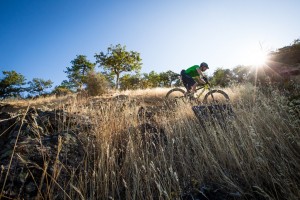Technical climbing is one of those mountain bike skills that will make your rides a whole lot more enjoyable and satisfying once dialled in. Less stalling when the trail pitches upwards will boost the flow of your rides and can really help make you a more complete rider, not to mention an object of envy amongst your riding buddies.
Granted, you can’t master technical climbing from an arm chair, but there are certainly some fundamentals that you can take to the trails that will have you clearing the most technical of climbs in no time at all! So, here are 5 key tips for clearing those tricky uphills on your mountain bike.
1. Approach with the right speed
With any technical climb, there’s a right approach speed and a wrong approach speed! Ride into a climb too fast and you might find yourself clattering into rocks and roots, and bouncing out of control very quickly indeed. Come in too slow though, and you’ll be unable to use your momentum properly, where you’ll likely have to spend a lot of energy just to keep the bike moving forward.
Where possible, try to approach a technical climb on the trail at a speed which won’t see you out of control as soon as you hit the rough stuff, but fast enough that you can use some controlled pedalling to keep your speed up and the bike light over the trail. Most of the time, you’ll want to approach such a climb at roughly the same speed that you’ll maintain until the top.
2. Select the right gear
Gear selection is one of the most important things to get right when hitting a tricky climb. Use a gear that’s too big and you’ll find it difficult to keep your momentum going and almost impossible to pedal smoothly.
Use a really small gear though and you could be bouncing up and down on the saddle and not getting enough power to the rear wheel. A cadence of around 80-90 RPM should allow you to pedal in a smooth, circular stroke which is key to maintaining grip, but which will also help you maintain the speed you carried into the climb.
Always try to choose a gear that’s on the easier rather than harder side, as this will allow you to inject a surge of speed and power much more easily if necessary.
3. Perch on the nose of the saddle
Tackling steep, tricky climbs is a balancing act between keeping enough weight on the front of the bike to stop the wheel from lifting and bouncing around, and having enough of your weight towards the back wheel to maintain traction.
On smoother climbs, getting out of the saddle and standing on the pedals might be your best bet, but on the really loose stuff, you’ll need to stay seated to keep the rear wheel from skidding out. To do this, shift your weight forwards by bending your arms and perching on the nose of your saddle.
By putting more pressure on the handlebars with your weight through your arms, you’ll keep the front wheel going where you want it to, but maintain enough weight on the back of the bike to keep the rear wheel turning and stuck to the ground, just where you want it to be.
4. Choose the right line
We all know that line choice is critical when descending, but it might be even more important when the trail goes upwards too. When climbing steep and technical sections, changing your line severely can be really difficult, so it’s imperative to choose the right one as you start the climb.
The right line is often going to be a combination of the smoothest and the straightest, so try to spot one that will allow you to climb without too much steering and without having to negotiate too many difficult obstacles. When you think you’ve spotted your line, focus on it intently and resist the temptation to look at the rougher, more technical portions of the climb. As mountain bikers, we tend to go where we look, so always keep focussed on exactly where you want to go.
5. Engage your core muscles
Having a strong core or mid-section is often an overlooked part of good pedalling, but is actually where a lot of your power and balance comes from. Both power and balance are critical to climbing ability, especially when the trail underneath you is rocky and unstable!
Engaging the core muscles as you attack a climb will ensure that you can lay down as much power as possible to get you up and over tricky obstacles, as well as allow you to move your upper body from side to side for balance, without hindering the ability of your legs to keep pedalling smoothly and powerfully.
You can practice this on the bike, and also use some simple exercises like planks, side-planks and crunches to work on your core strength off the bike too, if you can find the time and/or motivation of course!
So there are a few technical climbing fundamentals that you can take straight to the trails. Let us know how you got on and if you have any tips or tricks of your own that you think we should know about!
Image credit: Leslie Kehmeier, Mapping Manager, International Mountain Bicycling Association on Flickr



Recent Comments